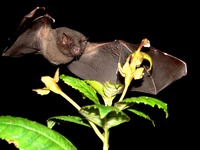Flowers pollinated by bats have a bit of a reputation. Their male sex organs are especially big. And they “produce a ton of pollen” compared with other flowers, says biologist Nathan Muchhala of the University of Toronto in Canada. They need to, ecologists had assumed, because bats are sloppy pollinators. But a new study suggests the opposite: Bats are so good, it pays to pile on the pollen.
Bats pollinate a few hundred species of plants in the New World. Most of these plants evolved from ancestors pollinated by hummingbirds. As part of that evolution, the plants traded gaily colored daytime flowers for dull evening blooms. The flowers visited by bats also produce about seven times more pollen than flowers catering to hummingbirds, but that increase has been hard to explain. One hypothesis has been that bats are just not very efficient pollinators: Perhaps they waste much of the pollen they pick up during their nectar runs by eating it or by grooming.
But Muchhala, a postdoc in the lab of pollination biologist James Thomson, thought it was the hummingbirds that looked wasteful. Working in an Ecuadorian cloud forest, he noticed that a hummingbird could collect a bright patch of pollen on its head, then arrive at the very next flower with just a “light gray dusting.” Bats kept more pollen in place from one flower to the next.
To test this observation, Muchhala and colleagues netted nectar bats (Anoura fistulata and A. geoffroyi) and picked flowers of Aphelandra acanthus, a bat-pollinated plant that still attracts some hummingbirds. The researchers released each bat in a flight cage and doled out flowers one by one to the bats, working until 3 or 4 a.m. First, they’d place a male flower in a test tube vase on a table. The bat would dart in, snatch a sip of nectar, and leave. Then the team gave the bats a female flower to deposit the pollen on. Muchhala and Thomson found that the more pollen a bat removed, the more it deposited—a pattern that held true over dozens of flower visits by six bats.
But when the researchers repeated the experiment with glossy little hummingbirds, the birds delivered just a few pollen grains to the female flowers, regardless of how many they removed from the male flowers. On average, the birds deposited only one-tenth as much pollen as bats, the team reports in the June issue of The American Naturalist. Muchhala thinks the feathers just don’t hold pollen as well as fur does. But to be sure, he wants to repeat the study with pollen from hummingbird-adapted, rather than bat-adapted, flowers.
The results could explain why bat flowers evolved to make so much pollen. Because bats are so efficient at transferring the pollen from one flower to the next, flowers with more pollen benefit by entering more grains in the competition to fertilize a female flower, Muchhala says. For a hummingbird flower, though, extra pollen would only fall off and be a waste of resources.
Evolutionary ecologist Nickolas Waser of the University of Arizona, Tucson, says that’s a logical explanation, and he praises the work as one of a small handful of studies that measure reproductive returns on a plant’s investment in pollen. He wonders, however, whether bats also influenced the evolution of female flower parts. Theory predicts that if a plant spends more energy on pollen, it will have less to invest in its female organs. But that, says Muchhala, is “a whole other complicated experiment.”




Great study Nathan!!